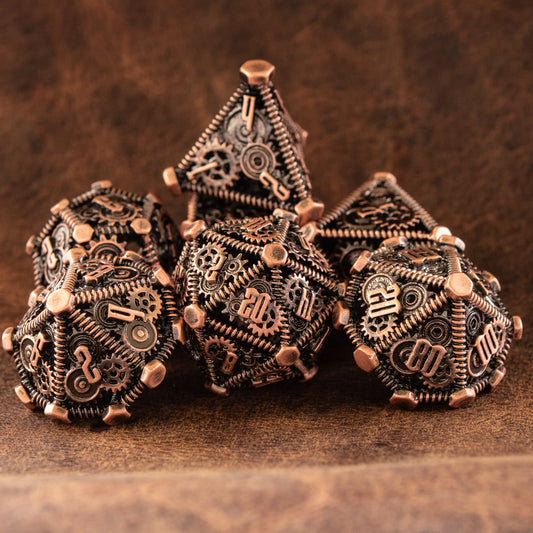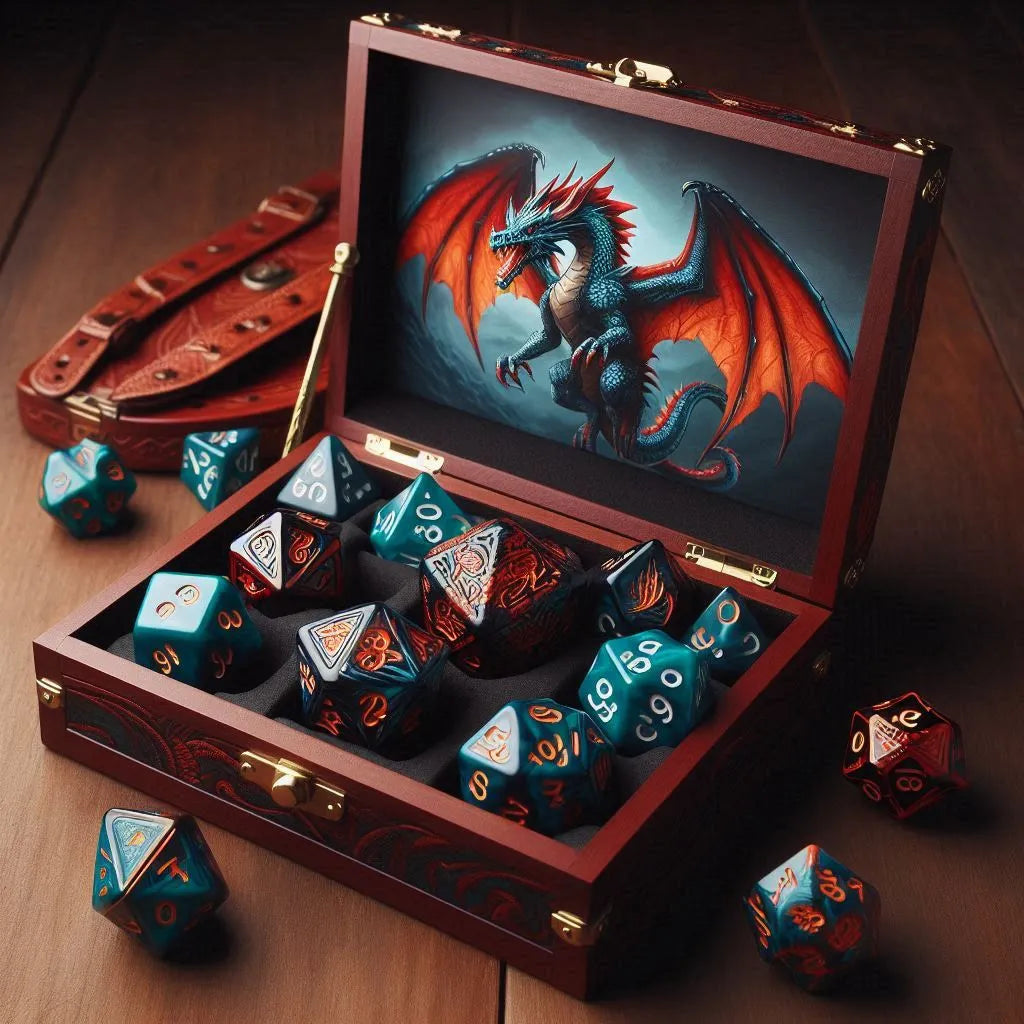The Polyhedral Dice Set
- D4 (4-sided die)
- D6 (6-sided die)
- D8 (8-sided die)
- D10 (10-sided die)
- D12 (12-sided die)
- D20 (20-sided die)
Materials: Beyond Plastic
-
Acrylic and Resin: The Staples of Polyhedral Dice
-
Acrylic Dice: These are the most common dice found in D&D. Acrylic is affordable, durable, and allows for vibrant, translucent colors. The manufacturing process of acrylic dice involves pouring liquid acrylic into molds and then polishing the dice to achieve a smooth finish.
-
Resin Dice: Similar to acrylic, resin offers flexibility in design. Resin dice can include intricate inclusions like glitter, flowers, or even tiny figures. These dice are often handcrafted, making each set unique.

Metal: The Weight of Authority- Metal dice are revered for their heft and durability. Typically made from zinc alloy, brass, or aluminum, these dice can be plated with various finishes such as chrome, gold, or antique bronze. The weight of metal dice provides a satisfying tactile experience, though it requires the use of a dice tray to protect surfaces.

Stone and Wood: Natural Elegance-
Stone Dice: Crafted from natural stones like jade, obsidian, or quartz, stone dice offer a unique aesthetic. However, they are more fragile and expensive compared to other materials.
-
Wooden Dice: These dice provide an organic, rustic feel. Each set of wooden dice is typically handcrafted from various types of wood, each with its own unique grain and color.
Exotic Materials: For the Aficionados- Some dice enthusiasts seek out dice made from exotic materials such as bone, glass, or even semi-precious gems. These custom-made dice are often collector's items, prized for their uniqueness and craftsmanship.
The Manufacturing Process
The creation of D&D dice is a blend of art and science. The process varies depending on the material but generally includes the following steps:
-
Design and Molding:
- Using computer-aided design (CAD) software, the dice are designed, and molds are created. These molds can be simple for acrylic and resin dice or more complex for metal and stone dice.
-
Casting:
- The chosen material is poured into the molds. For plastic dice, this involves injection molding. Metal dice are often cast using a method called spin casting.
-
Polishing and Finishing:
- Once the dice have set and hardened, they are removed from the molds and polished to ensure smooth surfaces and sharp edges.
-
Engraving and Painting:
- Numbers or symbols are engraved onto the dice faces and then filled with paint. High-quality dice may have deeply engraved numbers that are carefully hand-painted.
-
Quality Control:
- Each die is inspected for defects and tested for balance to ensure fair rolls. This step is crucial to maintaining the integrity of the game.
The Role of Dice in D&D Gameplay
Dice are more than just tools for randomization in D&D; they are integral to the storytelling and gameplay experience. Here are several ways in which dice impact the game:
-
Determining Success or FailureThe most fundamental role of dice in D&D is to determine the success or failure of a character's actions. When a player declares an action, such as attempting to pick a lock or attack an enemy, they roll the appropriate die (often a D20) and add any relevant modifiers. The Dungeon Master (DM) compares the roll to a target number called the Difficulty Class (DC). If the roll meets or exceeds the DC, the action succeeds; otherwise, it fails.
- Example: A rogue tries to pick a lock with a DC of 15. The player rolls a D20 and adds their Dexterity modifier and proficiency bonus, totaling 16. The rogue successfully picks the lock.
-
Adding Tension and ExcitementThe unpredictability of dice rolls adds tension and excitement to the game. Players never know for certain whether their actions will succeed, creating suspense and engagement. Critical hits (rolling a natural 20) and critical failures (rolling a natural 1) add dramatic moments to gameplay.
- Example: In the heat of battle, a fighter rolls a natural 20 on their attack roll, resulting in a critical hit that deals double damage, turning the tide of the fight.
-
Encouraging Creativity and Problem-SolvingThe possibility of failure forces players to think creatively and come up with alternative solutions when their initial plans don't work out. The dice rolls encourage players to consider different approaches and use their resources wisely.
- Example: A wizard's spell fails to immobilize a rampaging monster due to a poor roll. The party quickly devises a new plan, using environmental features like a collapsing bridge to trap the creature instead.
-
Balancing GameplayDice rolls introduce an element of chance that can balance the game. They ensure that even the most powerful characters can fail and that weaker characters have a chance to succeed. This randomness prevents the game from becoming too predictable or one-sided.
- Example: A low-level bard manages to charm a high-ranking villain with a lucky roll, gaining valuable information that helps the party thwart an impending threat.
-
Immersing Players in the Game WorldRolling dice and interpreting the results help immerse players in the game world. The physical act of rolling dice, the sound they make, and the anticipation of the outcome all contribute to the immersive experience.
- Example: As the party navigates a treacherous dungeon, the DM asks for a perception check. The players roll their dice, and the results reveal hidden traps and secret doors, adding to the sense of exploration and danger.
-
What’s the Best Racial Trait in D&D 5e? A Playe...
If you’ve spent any time in character creation — especially the kind that spirals into hours of debate around racial traits — you know how central this question can feel:...
What’s the Best Racial Trait in D&D 5e? A Playe...
If you’ve spent any time in character creation — especially the kind that spirals into hours of debate around racial traits — you know how central this question can feel:...
-
Respect Your NPCs’ Time, Dude: Why Player Behav...
Running a campaign as a Dungeon Master (DM) can be one of the most rewarding creative experiences in tabletop gaming. You craft worlds, narratives, compelling encounters, and a cast of...
Respect Your NPCs’ Time, Dude: Why Player Behav...
Running a campaign as a Dungeon Master (DM) can be one of the most rewarding creative experiences in tabletop gaming. You craft worlds, narratives, compelling encounters, and a cast of...
-

Affordable DnD Dice under $15: Quality Options ...
When diving into the world of Dungeons & Dragons, selecting dice that are both reliable and affordable can enhance your gameplay experience without breaking the bank. Whether you're a newcomer...
Affordable DnD Dice under $15: Quality Options ...
When diving into the world of Dungeons & Dragons, selecting dice that are both reliable and affordable can enhance your gameplay experience without breaking the bank. Whether you're a newcomer...
1 / of 3Subscribe to our emails
Be the first to know about new collections and exclusive offers.
- Choosing a selection results in a full page refresh.
- Opens in a new window.
-






